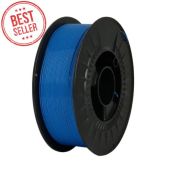We use cookies to make your experience better. Read more
16 April, 2025
What Is PETG Filament Used For?
Polyethylene Terephthalate-Glycol modifed, commonly known as PETG, is a popular 3D printing filament renowned for its durability, chemical resistance, and ease of use. Combining the advantageous properties of both PLA and ABS, PETG has become a go-to material for various applications across multiple industries.
Key Properties of PETG Filament
- Enhances durability and impact resistance due to glycol modification
- Strong, flexible, heat and chemical resistant
- Excellent layer adhesion with minimal warping
- No strong odors during printing compared to ABS
- Better UV resistance, suitable for outdoor use
- Good transparency for clear and translucent prints
Common Applications of PETG Filament
Functional Prototyping
Ideal for creating prototypes requiring mechanical strength and flexibility, ensuring resilience and longevity in real-world applications.
Mechanical Parts and Industrial Applications
Used for gears, brackets, housings, and other mechanical components due to its robustness and wear resistance, suitable for automotive, manufacturing, and robotics industries.
Outdoor Applications
Thanks to UV and weather resistance, PETG maintains structural integrity outdoors, used for garden tools, signage, and protective casings.
Medical and Food Containers
Valued for chemical resistance and sterilizability, PETG is used in medical device packaging, kitchenware, water bottles, and food storage, complying with FDA standards.
Artistic and Aesthetic Projects
Its glossy finish and transparency make it popular for artistic items like vases, lampshades, and decorative pieces.
Custom Enclosures and Electronic Cases
Used for electronic device enclosures due to its electrical insulation and chemical resistance, maintaining shape during printing.
Medical Prosthetics and Assistive Devices
Strength and biocompatibility make PETG suitable for prosthetics, orthopedic supports, and braces, with sterilization capabilities for medical use.
Advantages of Using PETG Filament
- High impact resistance and durability
- Resistant to acids and alkalis
- Easy to print with good layer adhesion
- Produces transparent, aesthetic prints
- Weather and UV resistant
- Biocompatible for food and medical applications
Considerations When Printing with PETG
- Prone to stringing; adjust retraction and temperature settings
- Strong bed adhesion can make removal challenging; use suitable surfaces
- Hygroscopic; store in dry environment to prevent moisture absorption
- Requires higher printing temperatures (230°C - 250°C)
By understanding these properties and considerations, users can effectively utilize PETG filament to create a wide range of durable and functional 3D printed objects.
About Us
At 3D Trček, we are a manufacturing enterprise specializing in the processing of thermoplastic elastomers and silicone rubber. With years of expertise, we offer a complete solution from tool-making to final product development. Our range of materials includes PVC, PP, PE, PS, PA, EVA, PMMA, PU, ABS, TPE, and silicone rubber. We are committed to delivering high-quality manufacturing solutions while providing expert guidance on material selection. Our goal is to meet customer requirements efficiently and adhere to international quality standards by continuously investing in new knowledge and technology.
Comment(s)



Please complete your information below to login.
Sign In
Create New Account